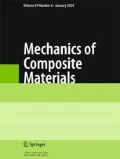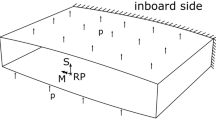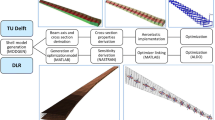The application of asymmetric composite materials in such adaptive structures as fan blades, fixed-wing aircrafts, and tilting rotors can lead to more deformation modes and good mechanical properties still remaining hygrothermally stable. But the influence of the extension-bending coupling effect on their mechanical properties is unknown. The wing skin is taken as an example to obtain a variety of hygro-thermally stable laminates with the extension-bending coupling effect by the optimal design method. It is compared with laminates with no extension-bending coupling effect by theoretical calculations and simulation verifications. The merits and demerits of the extension-bending coupling effect on other coupling effects, yield strength and buckling load of asymmetric composite structures have been clarified.

Similar content being viewed by others
References
R. A. Haynes and E. A. Armanios, “New families of hygrothermally stable composite laminates with optimal extensiontwist coupling,” AIAA Journal, 48, No. 12, 2954-2961 (2010).
R. A. Haynes and E. A. Armanios, “The challenge of achieving hygrothermal stability in composite laminates with optimal couplings,” International Journal of Engineering Science, 59 (2012).
C. B. York, “Unified approach to the characterization of coupled composite laminates: hygrothermally curvature-stable configurations,” International Journal of Structural Integrity, 2, No. 4, 406-436 (2011).
C. B. York, “On extension-shearing coupled laminates,” Composite Structures, 120, 472-482 (2015).
C. B. York, “Tapered hygrothermally curvature-stable laminates with non-standard ply orientations,” Composites Part A: Applied Science and Manufacturing, 44, 140-148 (2015).
J. Li and D. K. Li, “Multi-objective optimization of hygrothermally curvature-stable antisymmetric laminates with extension-twist coupling.” Journal of Mechanical Science and Technology,” 28, No. 4, 1373-1380 (2014).
J. Li and D. K. Li, “Extension-shear coupled laminates with immunity to hygrothermal distortion,” Composite Structures, 123, 401-407 (2015).
D. Cui and D. K. Li, “Optimization of hybrid laminates with extension-shear coupling,” International Journal of Aerospace Engineering, 1-12 (2018).
D. Cui and D. K. Li, “Optimization of extension-shear coupled laminates based on differential evolution algorithm,” Mech. Compos. Mater., 54, No. 6, 799-814 (2019).
R. M. Christensen, Mechanics of Composite Materials, John Wiley & Sons, New York—Chichester—Brisbane—Toronto (1979).
R. Kolisch and S. Hartmann, “Experimental investigation of heuristics for resource-constrained project scheduling: An update,” European Journal of Operational Research, 174, No. 1, 23-37 (2006).
J. Majak and S. Hannus, “Orientational design of anisotropic materials using the Hill and Tsai–Wu strength criteria,” Mech. Compos. Mater., 39, No. 6, 509-520 (2003).
R. J. Cross, R. A. Haynes, and E. A. Armanios, “Families of hygrothermally stable asymmetric laminated composites,” Journal of Composite Materials, 42, No. 7, 697-716 (2008).
D. Cui and D. K. Li, “Bending-twisting coupled structures based on composite laminates with extension-shear coupling effect,” Composite Structures, 209, No. 1, 434-442 (2019).
P. Yarrington, J. Zhang, C. Collier, et al., “Failure analysis of adhesively bonded composite joints,” Aiaa/asme/asce/ahs/asc Structures, Structural Dynamics, and Materials Conference (2005).
Acknowledgement
The authors gratefully acknowledge the support of the National Natural Science Foundation of China (Grant No. 11,472,003).
Author information
Authors and Affiliations
Corresponding author
Additional information
Russian translation published in Mekhanika Kompozitnykh Materialov, Vol. 56, No. 6, pp. 1127-1140, November-December, 2020.
Rights and permissions
About this article
Cite this article
Cui, D., Li, D. The Effect of Importing Extension-Bending Coupling into Asymmetric Composite Structures. Mech Compos Mater 56, 779–788 (2021). https://doi.org/10.1007/s11029-021-09923-8
Received:
Revised:
Published:
Issue Date:
DOI: https://doi.org/10.1007/s11029-021-09923-8




